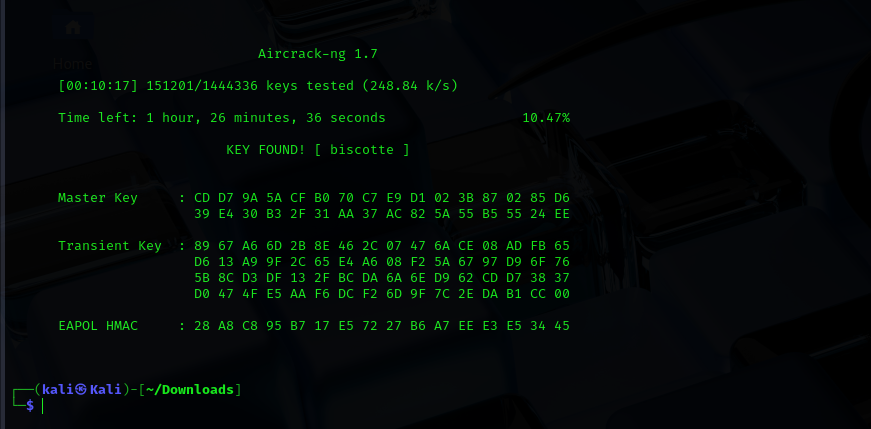WIFI Password Cracking
Introduction
In this lab, we analyze a captured WPA handshake wpa.cap to demonstrate the process of cracking a Wi-Fi password using dictionary-based attacks. WPA2-PSK (Wi-Fi Protected Access) secures wireless networks using pre-shared keys. However, if an attacker captures the 4-way handshake, the password can be brute-forced using a wordlist.
1. WPA Handshake
Before attempting to crack the password, it’s essential to confirm that the .cap file contains a valid WPA 4-way handshake. We use tshark to inspect the capture file for EAPOL (Extensible Authentication Protocol over LAN) packets, which are part of the handshake process.
run the command: tshark -r wpa.cap -Y "eapol"
This filters the packet capture for only EAPOL packets. The output shows the messages exchanged between the access point and the client device:
From the screenshot above, at least 3 of the 4 required EAPOL packets Message 1, 2, and 3. This confirms that the WPA handshake has been successfully captured, and we can go ahead and try to crack the password.
2. Extract the BSSID
We need the BSSID (MAC address) of the access point (AP) that sent the beacon frames. This helps aircrack-ng target the correct network during the brute-force process.
1
Run the command: tshark -r wpa.cap -Y "wlan.fc.type_subtype == 0x08" -T fields -e wlan.bssid
-r wpa.cap: Reads the capture file.-Y "wlan.fc.type_subtype == 0x08": Filters for beacon frames which advertise networks.-T fields -e wlan.bssid: Extracts the BSSID field from those frames.
00:0d:93:eb:b0:8c: This is the BSSID of the target Wi-Fi access point. We will use this MAC address when running aircrack-ng to crack the password.
3.Cracking the WPA Password with aircrack-ng
With the handshake verified and the BSSID extracted, we can now attempt to brute-force the WPA2 password using aircrack-ng and a wordlist.
1
Run the command: aircrack-ng -w /usr/share/wordlists/rockyou.txt -b 00:0d:93:eb:b0:8c wpa.cap
-w /usr/share/wordlists/rockyou.txt: specifies the wordlistrockyou.txtused to try possible passwords.-b 00:0d:93:eb:b0:8c: targets the access point identified by its BSSID (MAC address).wpa.cap: the capture file containing the WPA handshake.
Password Recovered
Cracked Wi-Fi Password: biscotte 🔐
Mitigation Tips
To protect wireless networks from attacks like WPA handshake capture and password cracking, the following best practices should be implemented:
1. Use Strong, Complex Passwords
Avoid common passwords that appear in public wordlists like rockyou.txt. A secure WPA2 password should:
- Be at least 12–16 characters
- Include uppercase, lowercase, numbers, and symbols
- Avoid dictionary words or personal information
2. Rotate Wi-Fi Credentials Periodically
Change Wi-Fi passwords regularly, especially after employee turnover or suspicious activity.
3. Monitor for Rogue Devices & Deauth Attacks
Use wireless intrusion detection systems (WIDS) to detect:
- Repeated deauthentication frames
- Rogue access points mimicking your SSID
- Suspicious MAC addresses attempting handshake captures
4. Disable WPS (Wi-Fi Protected Setup)
WPS is vulnerable to brute-force attacks and should be disabled on all routers and access points.




